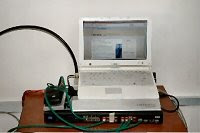 You need to provide full internet and Wi-Fi services to hundreds of people.
You need to provide full internet and Wi-Fi services to hundreds of people.How can it be done? Read on!
One solution is SolarNetOne, designed and built specifically for the purpose.
It uses a solar panel and battery system to provide a reliable long-term source of energy, and a low-power server using a satellite connection to access the internet. Internet cafe service is based on a client server system as this reduces the power requirements, and Wi-Fi coverage over a two mile radius is included so anyone with their own computing system and power supply can connect to the internet very simply.
SolarNetOne really is a complete solution.
Zee M kane writes...
SolarNetOne is a collaborative effort spanning several continents, organizations, and technical disciplines. The goal of the effort is to develop a feasible, sustainable solution to bring the internet to places that have no connectivity, no phone service and no electricity.
Developed by Florida based GNUveau, the system is a solar-powered Internet “hub” (running Ubuntu GNU/Linux). The terminals includes access to web browsing, email, voip, office, multimedia, software development and web development tools as well as 15,000 other applications. Wifi coverage spans a 2-mile radius, with no fuel costs, no polluting emissions and a long lifespan of up to 20 years with proper maintenance. The entire system, in fact, operates on about the same amount of power as a 100-watt light bulb, GNUveau says.
It's not the most elegant approach in terms of appearance, but much more significantly it's robust and readily maintainable and consumes only 100 W of power. The entire system can be delivered in a single small van (if there are adequate roads). The small bulk means delivery by small aircraft or boat would also be possible.
The guy behind all this is Scott Johnson. Well done Scott, you get my vote! This is real, practical help to people who need it. Katsina State University in Nigeria is already benefitting. Hopefully many more installations will follow.
For more information take a look at the following resources.
- GNUveau Networks - no prizes for web usability or design excellence!
- Google search - more sources of information on the system
- SolarNetOne Project - The first installation (in Nigeria)
- SolarNetWiki - system description
- Zee M Kane's blogpost - includes a video presentation
















